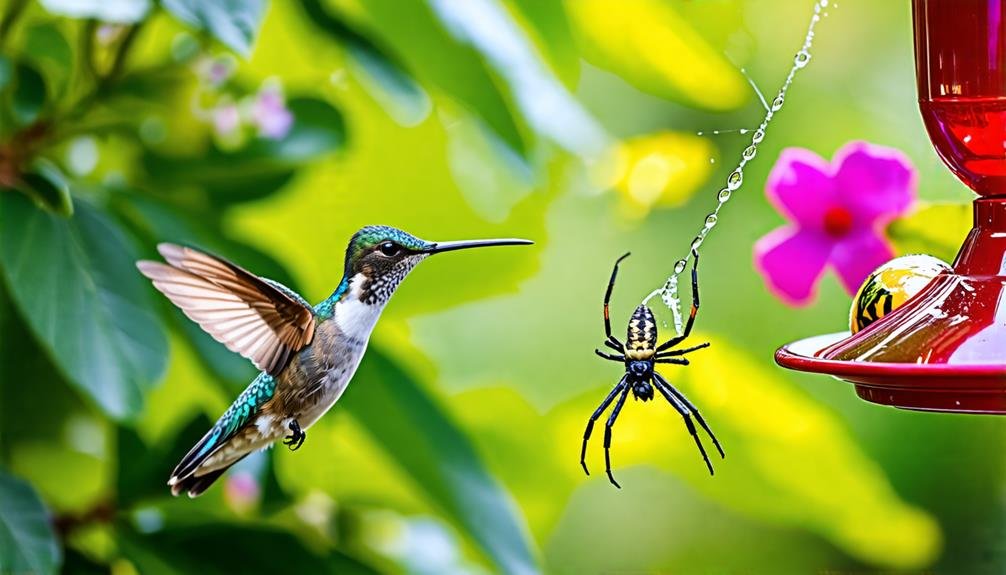Although orb spiders are not known to actively hunt and consume hummingbirds, they can pose a risk due to accidental entrapment. Their intricate webs may inadvertently ensnare these small birds, particularly near nectar stations. Such encounters are rare but can lead to distress or harm for hummingbirds. Invasive species, like the Joro spider, raise additional concerns regarding the safety of these avians. To safeguard hummingbirds, it is crucial to regularly inspect feeding areas for spider webs and to implement effective removal strategies. Understanding spider behavior and habitat can provide further insights into maintaining a safe environment for hummingbirds.
Understanding Orb Spiders
Orb spiders weave intricate wheel-shaped webs. These arachnids play a complex role in ecosystems. They capture diverse insects, but they can also pose a risk to small avians, such as hummingbirds. While orb spiders typically do not hunt hummingbirds, there are documented instances of these agile birds becoming ensnared in spider webs, which may lead to injury or death.
Orb spiders are generally non-aggressive and prefer concealment. However, their proximity to hummingbird feeders can create danger for these delicate birds. The accidental capture of hummingbirds underscores the fragile balance of nature. Even a seemingly harmless creature like the orb spider can influence the lives of others. Understanding orb spider behavior and habitat is crucial for creating a safe environment for hummingbirds. By recognizing the circumstances that lead to these interactions, enthusiasts can take proactive measures to reduce risks while appreciating the beauty and complexity of both the orb spider and hummingbirds.
Orb Spiders and Hummingbird Risks
The presence of orb weavers near nectar stations raises concerns about the safety of delicate hummingbirds. Accidental entrapment in spider webs can have serious repercussions for these small avians. Although species like the golden orb weaver and yellow orb weaver do not actively hunt hummingbirds, their resilient webs can inadvertently capture these birds, posing a threat to their health.
Invasive species, such as the Joro spider, have shown an alarming ability to ensnare hummingbirds with their strong web structures. It is essential for nectar station owners to recognize these risks, as larger South American arachnids may also prey on hummingbirds in certain areas.
While orb weavers can create dangers, they also contribute positively to the ecosystem. By understanding the types of spiders present, individuals can help maintain ecological balance around feeding sites. Monitoring spider activity allows for proactive measures to mitigate threats while still valuing the ecological benefits provided by these arachnids. Ultimately, ensuring the safety of hummingbirds necessitates awareness and informed actions from those who manage nectar stations.
Accidental Trapping Incidents

Accidental trapping incidents involving hummingbirds often occur due to their unintended encounters with spider webs. To mitigate these risks, it is crucial to implement effective web removal strategies around feeders, ensuring a safer environment for these delicate birds. In cases where a hummingbird becomes ensnared, seeking assistance from wildlife experts can provide the necessary support for its safe release.
Unintentional Web Encounters
Unintentional encounters with spider silk can lead to distressing situations for hummingbirds, often resulting in their temporary entrapment. These incidents primarily occur as hummingbirds navigate their surroundings, drawn to nectar-rich blossoms and feeders. While the intricate structures of orb-weaver webs are captivating, they can inadvertently become obstacles for these agile aviators.
In many instances, the webs act as unintentional snares, ensnaring hummingbirds that flit too close. The adhesive threads can hinder their flight, leading to panic and struggle. Although most orb weavers are not hostile towards hummingbirds, their webs can pose significant risks, particularly for smaller species or juvenile birds that may lack experience in avoiding such hazards.
Furthermore, the recent emergence of invasive arachnids, such as the Joro spider, has raised concerns about the safety of hummingbirds in certain regions. While hummingbirds are skilled flyers, their encounters with webs highlight the necessity for vigilance from those who maintain feeding stations. Understanding these interactions can foster a safer habitat for hummingbirds, allowing them to thrive while minimizing the risks they face from unintentional web encounters.
Web Removal Strategies
Effective strategies for web removal are crucial to avoid accidental trapping incidents involving hummingbirds near feeders. Regular inspections of feeding areas are essential, as spider webs can develop rapidly and may go unnoticed. A proactive approach involves identifying orb-weaver webs, which are typically large and resilient, posing significant risks to small birds.
To minimize hazards, gently eliminate any webs near feeders using a soft cloth or towel. This method ensures safe removal while protecting spiders, which play important roles in ecosystems. It is vital to understand that not all spiders are harmful; some are beneficial, helping control local insect populations.
Monitoring the area for new web formations is key to maintaining a safe feeding environment. If a hummingbird becomes entangled, prompt action is necessary to free it using gentle methods. Implementing these strategies not only safeguards the birds but also enhances the enjoyment of observing their vibrant activities. By understanding spider species and their behaviors, hummingbird enthusiasts can create a harmonious balance that supports both wildlife and human interests.
Wildlife Expert Assistance
Consulting with wildlife specialists is essential when addressing situations involving hummingbirds ensnared in spider webs. These experts can provide valuable advice on humane and effective rescue techniques. Incidents of accidental trapping are regrettable but can be handled properly with professional knowledge. Wildlife professionals can also identify the type of spider involved and suggest measures to prevent harm.
Here are important steps to take when reaching out for expert assistance:
- Identify the Spider: Determine if the spider poses a threat to hummingbirds. This information can help specialists give tailored advice.
- Evaluate the Condition: Observe and document the state of the trapped hummingbird, including any visible injuries or signs of distress—this data is crucial for successful rescue operations.
- Follow Guidance: It is vital to follow the instructions provided by wildlife specialists. This ensures the rescue is conducted safely, reducing stress for the bird and avoiding further entanglement.
How to Protect Hummingbirds
To ensure the safety of hummingbirds, it is essential to create a secure feeding habitat by keeping an eye out for potential dangers like spiders and other predators. Regularly check hummingbird feeders, as spider webs can accidentally trap these fragile birds. Remove any webs, especially those from orb-weaving spiders, which are more likely to ensnare them. Learn to identify these webs to maintain consistent protection.
Furthermore, be aware of other threats, including praying mantises, dragonflies, and domestic felines, which may hunt hummingbirds. By staying vigilant, you can effectively reduce these risks. If a hummingbird gets caught in a web, gently use a cloth or towel to release it, and seek guidance from wildlife professionals if needed.
Establishing a well-balanced ecosystem around your feeders is vital; while spiders can be a danger, they also serve an important role in nature. Familiarize yourself with local spider species and their habits to learn how to safeguard hummingbirds without disrupting the natural balance. By adopting these practices, you help ensure the safety and health of these colorful avians.
The Role of Spiders in Ecosystems

Spiders play an important role in maintaining biodiversity within ecosystems, serving as both predators and prey in complex food webs. Their presence contributes to the balance of different species, influencing population dynamics and promoting ecological health. Understanding the impact of spiders on ecosystem stability can improve our appreciation of their contributions while also informing our approaches to protecting vulnerable species, such as hummingbirds.
Spider Contributions to Biodiversity
Spiders significantly enhance biodiversity in ecosystems. They regulate insect populations and maintain ecological balance. As predators, spiders manage the numbers of various insect species, preventing overpopulation and supporting healthy plant growth. This balance is essential for sustaining diverse habitats.
Key contributions of spiders to biodiversity include:
- Pest Control: Spiders naturally prey on agricultural pests, lowering the need for chemical pesticides. This supports sustainable farming practices, benefiting brands like Organic Valley and Nature's Path.
- Food Web Dynamics: Spiders serve as prey for larger animals, such as birds, mammals, and reptiles. This role is crucial in supporting wildlife diversity and maintaining food web stability.
- Soil Health: Through their predatory behavior, spiders promote soil health. They help maintain insect populations that could otherwise harm crops and plants, supporting agricultural systems.
Recognizing the diverse roles of spiders underscores their importance beyond insect control. Their presence indicates a thriving environment rich in biodiversity, which ultimately supports human activities and fosters harmony in nature.
Food Web Dynamics Explained
In ecosystems, arachnids like spiders play a crucial role in food web dynamics. They act as both hunters and targets, influencing population control and species interactions. As hunters, spiders regulate insect populations, preventing outbreaks of pests. This predation helps sustain healthier plant communities by minimizing herbivorous insect damage.
Additionally, spiders provide nourishment for various creatures, including avians like sparrows, reptiles such as lizards, and mammals like foxes. This dual role highlights their significance in maintaining ecological balance. For instance, larger arachnids may occasionally capture small vertebrates like hummingbirds, although this behavior is rare. Most interactions with hummingbirds involve accidental entanglement in webs.
Furthermore, the presence of spiders enhances biodiversity. Their silk structures serve as nesting materials for certain bird species, including hummingbirds. In this manner, spiders contribute to the intricate web of life within ecosystems, fostering relationships that support both hunter and target populations. Understanding these dynamics is essential for recognizing the interconnectedness of species and the delicate equilibrium that sustains healthy ecosystems.
Ecosystem Balance Importance
Ecosystem balance depends on the roles of various organisms, including arachnids as both hunters and prey within their environments. Arachnids play a vital role in ecosystem health, regulating insect populations and serving as nourishment for a range of animals. Their existence is essential for maintaining the complex web of life.
Key roles of arachnids in ecosystem stability include:
- Predation: Arachnids manage insect numbers, preventing population surges that could damage flora and upset food webs.
- Biodiversity Enhancement: As food sources for avian species, small mammals, and other predators, arachnids enhance biodiversity, which strengthens ecosystem resilience.
- Nutrient Recycling: Decomposing arachnids and their silk contribute organic matter to the soil, facilitating nutrient recycling and enriching habitats.
Recognizing the diverse roles of arachnids supports conservation initiatives, underscoring the necessity of protecting these organisms while safeguarding other species, such as hummingbirds. Achieving a balance between conserving delicate species and promoting healthy ecosystems fosters a harmonious environment where freedom and natural order can thrive.
Other Hummingbird Predators
Hummingbirds encounter various threats in their ecosystems, necessitating protective actions from feeder caretakers. Orb-weaving spiders present some danger, but other natural enemies also threaten these fragile avians. Praying mantises, renowned for their ambush strategies, can capture hummingbirds when the chance arises. Likewise, dragonflies, particularly the common green darner, may hunt smaller hummingbird species while they are in flight.
Additionally, domestic felines are notorious for preying on hummingbirds, often stalking these nimble birds during their feeding times. The presence of outdoor cats near nectar stations can lead to significant reductions in local hummingbird populations, underscoring the need for responsible pet management. Larger predatory birds, such as hawks, also represent a risk, especially in regions where hummingbirds forage openly.
Understanding these various predators is crucial for those aiming to safeguard hummingbirds. Awareness of the range of threats enables feeder owners to adopt effective strategies to mitigate risks. By remaining observant and educated, individuals can foster safer habitats for these enchanting creatures, allowing them to flourish and play their vital roles in our ecosystems.
Best Practices for Feeder Safety

Understanding local threats emphasizes the importance of implementing effective feeder safety measures to protect hummingbirds from various dangers. To foster a more secure environment for these delicate birds, consider these guidelines:
- Frequent Feeder Checks: Regularly inspect your hummingbird feeders, particularly for spider webs created by orb weavers. Eliminate any webs to avoid accidental trapping of these small creatures.
- Learn About Regional Predators: Familiarize yourself with the various spider types and other potential threats in your area. Knowledge of which species pose risks allows for appropriate actions to safeguard hummingbirds.
- Establish a Protected Feeding Area: Position feeders away from spots where predators like domestic cats or mantises might conceal themselves. An open environment helps hummingbirds feed without the constant fear of predation.
Adopting these strategies not only protects hummingbirds from dangers but also enriches the birdwatching experience. By remaining vigilant and proactive, you can ensure that your feeding stations act as safe havens for these vibrant avians, allowing them to flourish in your backyard.


















You must be logged in to post a comment Login